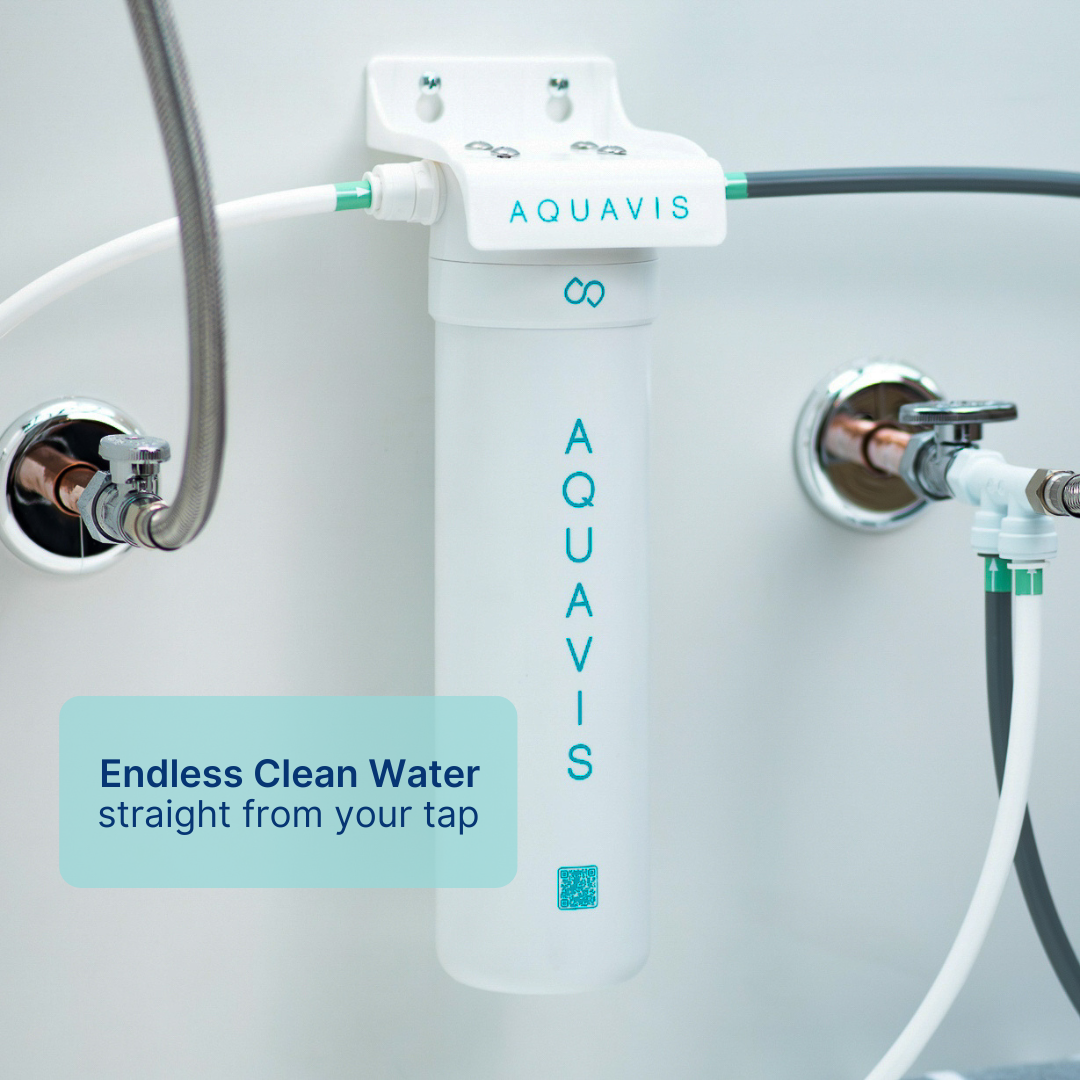Not all drinking water is the same. Unfiltered tap water can leave an unpleasant taste in your mouth (literally), and bottled water is filled with microplastics. Thankfully, with the right filter, you can have healthier, better tasting water in your home.
Two of the most popular options for home filtration systems are carbon filters and reverse osmosis. Both are great options, but function differently to improve the overall water quality in your home.
But which filter is best for you? Let’s dive in!
Carbon Filtration
Carbon filtration, such as activated carbon filters, use a porous carbon material to adsorb impurities from the water. These filters are effective in removing harmful contaminants like chlorine, organic compounds, and heavy metals, improving taste and odor.
What Is a Carbon Filter?
An activated carbon filter is a water purification device designed to enhance the quality of drinking water by utilizing activated carbon or charcoal as the primary filtration medium. The carbon material undergoes a process of activation, creating a porous structure with a large surface area.
As water passes through the filter, the activated carbon adsorbs and captures impurities, such as chlorine, organic compounds, and some chemicals, effectively improving the taste, odor, and overall clarity of the water.
Carbon filters are commonly found in various water treatment systems, including countertop pitchers, faucet attachments, refrigerator filters, and under-sink filters. These filters offer a versatile and effective means of achieving better water quality for consumption and other domestic uses.
How Does a Carbon Filter Work?
As water passes through the filter, the activated carbon adsorbs and captures impurities such as chlorine, organic compounds, and some chemicals. This process effectively removes bad tastes and odors from water while improving the overall clarity and giving you clean drinking water right at your fingertips.
Benefits
Carbon filters, including activated carbon filters, offer several benefits in water purification.
- Improved taste and smell: Carbon filters are highly effective in removing unpleasant tastes and odors from water, particularly by adsorbing chlorine, organic compounds, and volatile chemicals. This makes carbon filters an appealing choice for improving the taste of beverages like coffee and tea.
- Cost-effective and time-efficient: High-quality carbon filters are affordable, easy to install, and easy to maintain.
- Versatile and compatible: From faucet attachments to whole-house units, there are many carbon filter options to fit your needs. These options provide a convenient and accessible solution for households seeking improved water quality.
Limitations
Carbon filters are a great option for many households, but like all filters, they aren’t perfect.
- Filtration level limits: While they improve taste and odor by filtering contaminants, carbon filters may not be as effective in removing certain contaminants like minerals or microorganisms.
Individuals or organizations with specific water quality concerns (e.g. hospitals or dental offices) may need to utilize additional filtration methods to achieve higher purification levels.
- Lifespan limits: Like all filters, the lifespan of carbon filters is finite. Over time, the porous structure of the activated carbon may become saturated, reducing its adsorption capacity. Consequently, they require occasional replacement for optimal performance.
Despite these limitations, carbon filters remain a popular and practical choice for many households seeking a cost-effective and efficient means of improving their drinking water.
Advanced activated carbon filters like the Aquavis Pulse minimize these limitations by filtering for many of the harmful contaminants in your tap water, including “forever chemicals” (PFAS), lead, cysts, VOCs, and more. Because of their finite lifespan, the Aquavis Pulse system also makes replacement and maintenance simple, easy, and affordable—no professional help needed.
Reverse Osmosis
Reverse osmosis (RO) is a highly effective process that utilizes a semi-permeable membrane to remove a wide range of contaminants, including minerals, heavy metals, and microorganisms.
The RO process forces water through the semipermeable membrane, allowing only water molecules to pass while blocking larger particles. This method is particularly effective in producing purified water with a high level of contaminant removal. However, it tends to be a slower process and results in some water wastage during the filtration process.
Reverse osmosis is widely used for both residential and industrial applications, providing an efficient and comprehensive method for improving water quality.
How Do Reverse Osmosis Systems Work?
In a reverse osmosis (RO) system, water undergoes a meticulous purification process using a semipermeable membrane. Pressurized water is forced through this membrane, allowing only water molecules to pass through while contaminants like minerals, salts, and impurities are kept back.
From here, the clean and purified water continues on its way, while the contaminated water is expelled, providing high-quality, filtered water in both residential and industrial settings.
Benefits
RO filtration systems offer benefits to residential and industrial areas, alike.
- High filtration level: One of the primary advantages of a reverse osmosis water filtration system is its effectiveness in removing a wide range of contaminants, including minerals, dissolved solids, heavy metals, bacteria, and viruses.
- Versatility: Reverse osmosis is a versatile technology that can be applied at various scales, from residential units to large industrial water treatment systems, addressing the diverse needs of different settings.
Limitations
While RO is a useful system, there are drawbacks to note when considering reverse osmosis for your home.
Water waste: One significant drawback of RO is the substantial water waste that occurs during the filtration process. RO systems typically produce more wastewater than purified water, which can be a concern in regions facing water scarcity.
Over-purification: The RO process removes not only contaminants but also beneficial minerals from the water. This demineralization can affect the taste of the water and draw out minerals from the consumer’s body. In some cases, RO treated water may require remineralization to restore a balanced mineral content.
Cost and maintenance: Reverse osmosis systems can be expensive to install and maintain, requiring periodic membrane replacements and professional servicing to ensure optimal performance.
Some industries that require extremely pure water would likely benefit from this system, however it may not be as cost-effective for a residence.
Reverse Osmosis Versus Carbon Filters
Reverse osmosis (RO) and carbon filters are distinct water purification methods with notable differences in their mechanisms and applications. Reverse osmosis is a comprehensive process that employs a semipermeable membrane to selectively filter out a wide range of contaminants, including minerals, bacteria, and dissolved solids. This technology is highly effective in producing purified water but can be slow, expensive, and wasteful. RO systems also require expensive maintenance and extensive installation.
In contrast, carbon filters, such as activated carbon filters, use a porous carbon material to adsorb impurities, improving taste and odor by removing chlorine, organic compounds, and volatile chemicals. Carbon filters are generally faster than RO systems and do not produce wastewater, making them more water-efficient. However, carbon filters may not be as effective in removing certain minerals and bacteria. These filters are less expensive and easier to install and maintain.
The choice between reverse osmosis and carbon filters depends on specific water quality concerns, desired outcomes, and the trade-offs individuals are willing to make in terms of speed, water efficiency, and comprehensive purification.
Dive into Clean Water with Aquavis Carbon Filters
Aquavis carbon filters can provide your family with cleaner, healthier water in your home. These compact systems can be easily installed under your kitchen sink, giving you contaminant-free, tasty water right from your tap.
Superior to regular carbon filters, the Aquavis Pulse removes organic compounds, chlorine, PFAS, and heavy metals that are typically found in unfiltered tap water while keeping all the healthy minerals.
Ready to see how Aquavis can change your water quality? Try our filter today and keep your family healthy and hydrated.



